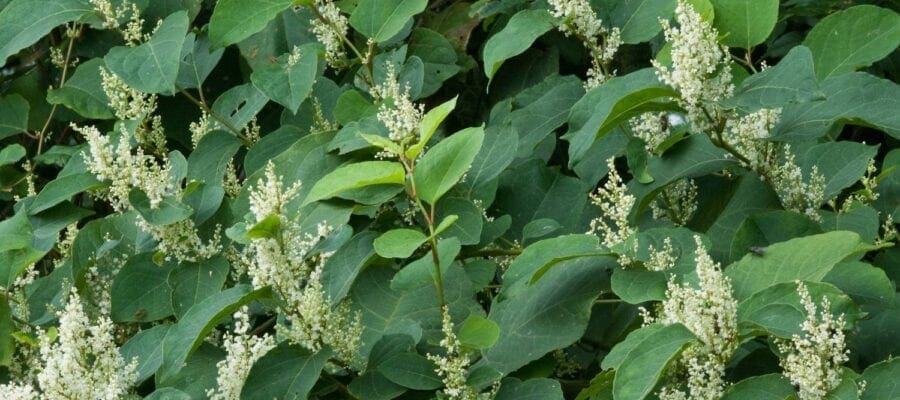This week 27 March – 2 April 2017 is Invasive Non-Native Species Week. Check out what you have growing in your garden
The GB Non-Native Species Secretatiat (NNSS) are keen to promote awareness of the non-native plant species that might be growing in your garden.
Gardens and parks frequently feature a diverse tapestry of non-native plant species, many of which have been present here for generations. However, sometimes these species prove to be invasive, for example by out-competing native plants or introducing new diseases.
Enjoy more Kitchen Garden reading in the monthly magazine.
Click here to subscribe & save.
Why does this matter?
• Invasive non-native species (INNS) now pose one of the greatest threats to biodiversity worldwide, including our own native flora and fauna.
• It has been estimated that controlling and compensating for damage caused by INNS costs the UK taxpayer around £1.7 billion a year.
• Around 60% of the non-native species causing damage to our natural environment in the UK originate from the horticultural industry.
• Even on nature reserves, a huge amount of time and money are spent tackling INNS such as New Zealand pygmyweed and floating pennywort. These two species were originally introduced to the UK as garden pond plants.
Plants to avoid
The following list provided by the NNSS are a just few frequently encountered in nurseries and garden centres. Some appear on the Schedule 9 lists of plants (S9) and the others appear on the Natural England Horizon Scanning (H) list.
Common name Botanical name
Butterfly-bush (H) Buddleia – all varieties*
Cotoneaster (S9 & H) Cotoneaster- all varieties
Montbretia (H) Crocosmia – all varieties
Russian vine (H) Fallopia baldschuanica
Shallon (S9) Gaultheria- all varieties
Spanish Bluebell (S9 & H) Hyacinthoides hispanica
Garden Privet (H) Ligustrum ovalifolium
Japanese Honeysuckle (S9 & H) Lonicera japonica
Wilson’s Honeysuckle (H) Lonicera nitida
False Virginia-creeper (S9) Parthenocissus inserta
Virginia-creeper (S9) Parthenocissus quinquefolia
Firethorn (H) Pyracantha- all varieties
Rhododendron (S9 & H) Rhododendron ponticum
Rhododendron hybrid (S9 & H) Rhododendron ponticum x R. maximum
False acacia (S9 & H) Robinia pseudoacacia
Many-flowered Rose (H) Rosa multiflora
Japanese rose (S9 & H) Rosa rugosa
White-stemmed Bramble (H) Rubus cockburnianus
Salmonberry (S9) Rubus spectabilis
Chinese Bramble (H) Rubus tricolor
Sorbaria (H) Sorbaria sorbifolia
* Buddleja alternifolia and Buddleja davidii x globosa (B. x weyeriana) are not known to be invasive.
The INNS advice you to note the very specific names, and if you’re asking for these at a garden centre or nursery be aware that any alternatives offered are likely to be invasive.
What is Schedule 9?
Schedule 9, Section 14A (2) of the Wildlife and Countryside Act 1981, refers to plants, specifically those listed on Part 2 of the Schedule, whereby it is an offence to plant or otherwise cause to grow in the wild invasive non-native plants listed on those Schedules and after April 2014 it became illegal to sell five invasive non-native aquatic plants.
What is the Horizon Scanning list?
In May 2008 the GB Strategy for Invasive Non-Native Species (INNS) was launched. One of the key elements was recognition of the need to prevent the introduction and/or spread of potentially invasive non-native species.
Determining which species will become invasive is notoriously difficult, the best predictor being evidence of invasiveness elsewhere. To assist in the prioritisation and targeting of prevention work, Natural England sought a horizon-scanning exercise to identify non-native plants that are most likely to become invasive in Great Britain in the future.
The outcome of this work was the publication of a report listing potential new invasive non-native plant species in Great Britain using existing information on INNS. These might be species, which are already here but are not established or species that are yet to arrive. A total of 599 non-native plants were assessed.
For more information visit: http://bit.ly/2mLvkqD
 Enjoy more Kitchen Garden reading in the monthly magazine. Click here to subscribe.
Enjoy more Kitchen Garden reading in the monthly magazine. Click here to subscribe.
Sign-up to the Kitchen Garden Magazine Newsletter
Enter your e-mail address below to see a free digital back issue of Kitchen Garden Magazine and get regular updates straight to your inbox…
You can unsubscribe at any time.
About the Author
- The Cottage Garden Society ‘Grow In Pots’ For The Malvern Show 9-12 May - 12th April 2024
- Arundel Castle’s Tulip Festival returns - 7th February 2024
- FREE TREES FOR SCHOOLS - 4th January 2024









